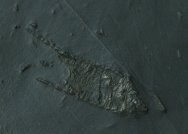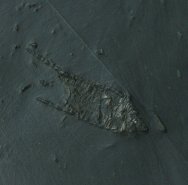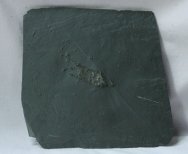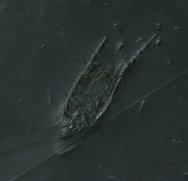Rhenocystis
latipedunculata
Phylum Echinodermata
Geological
Time:
Lower Devonian,
Seigenian/Emsian Stage
Size: (25.4
mm = 1 inch): Fossil is 44 mm by 10 mm on a 120 by 120 mm matrix
Fossil
Site: Hunsruck Slate, Bundenbach Germany
Code: B001
Price: Sold
 Description:
Well-preserved example of a anomalocystoid mitrate carpoid known
as Rhenocystis latipedunculata. The term mitrate derives from the
carpoid’s shape which is similar to a bishop’s mitre.
The Hunsruck slate is famous for its fossils, many of which have
pyritization present. Rapid burial and pyritization was what led
to the many wonderful examples of early Devonian life from the
region. The mudstones were metamorphosed into slate during the
Carboniferous. The slate was quarried for roofing tiles, and the
quarrymen would save the fossils for later sale. Now that the quarries
are no longer open, future supplies of these wonderfully-preserved
benthic organisms will only come from existing collections. The
carpoid body was supported by a skeleton of calcitic plates like
those found in modern Echinoderms. Some believe that a carpoid
may have been the common ancestor between Echinoderms and Vertebrates.
It is important to note the carpoids differ from ALL other animals,
living and extinct, in that many are completely asymmetrical. This
enigmatic fossil is infrequently offered, so this is a great opportunity
to add one to your collection. Description:
Well-preserved example of a anomalocystoid mitrate carpoid known
as Rhenocystis latipedunculata. The term mitrate derives from the
carpoid’s shape which is similar to a bishop’s mitre.
The Hunsruck slate is famous for its fossils, many of which have
pyritization present. Rapid burial and pyritization was what led
to the many wonderful examples of early Devonian life from the
region. The mudstones were metamorphosed into slate during the
Carboniferous. The slate was quarried for roofing tiles, and the
quarrymen would save the fossils for later sale. Now that the quarries
are no longer open, future supplies of these wonderfully-preserved
benthic organisms will only come from existing collections. The
carpoid body was supported by a skeleton of calcitic plates like
those found in modern Echinoderms. Some believe that a carpoid
may have been the common ancestor between Echinoderms and Vertebrates.
It is important to note the carpoids differ from ALL other animals,
living and extinct, in that many are completely asymmetrical. This
enigmatic fossil is infrequently offered, so this is a great opportunity
to add one to your collection. |
|



